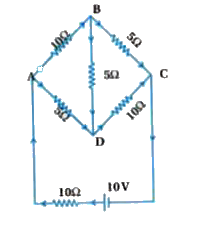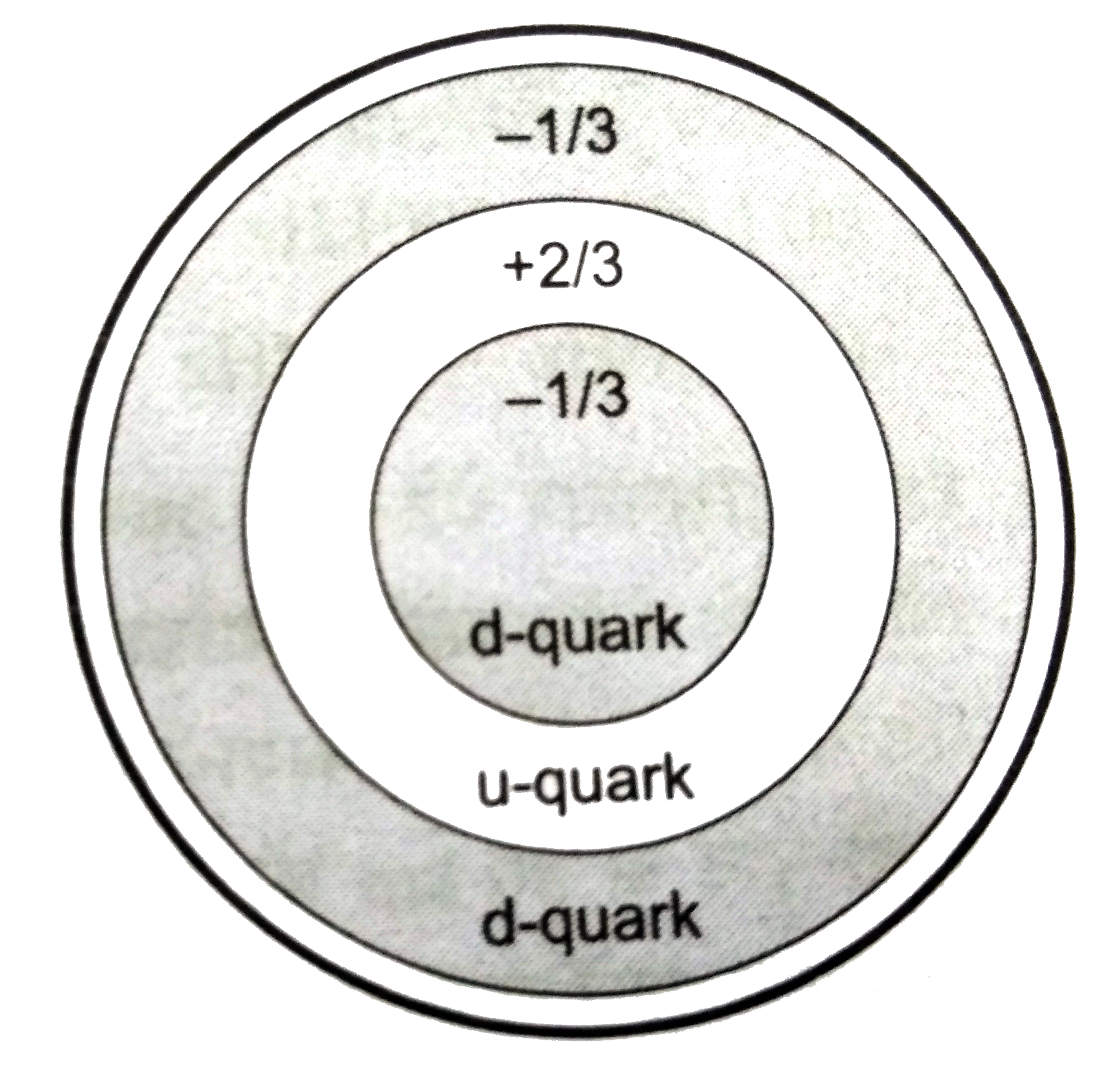In a quark model of elementary particles a neutron is made of one up quarks is made of one up quarks
[ charge 23e ] and two down quarks [ charges −13e ]. Assume that they have a triangle configuration with slde length of the order of 10−15 m. Calculate electrosatic potential energy of neutron and compare it with it, mass 939 MeV. Solution in Gujrati
Electrostatic potential energy U=kq1q2r
The system of three charges is as below
r=10−15 m
qu = up quarks =23 e

qd = down quarks = −13 e
Electrostatic potential energy
U=k(qdqdr+quqdr+quqdr)
U=k⎡⎢
⎢⎣(−13e)(−13e)r+(23e)(−13e)r+(23e)(−13e)r⎤⎥
⎥⎦
U=kr[19e2−29e2−29e2]
=ke29r×(−3)
=9×109×(1.6×10−19)2×(−3)9×10−15
=−7.68×10−14J
:U=−7.69×1014−1.6×10−19eV
∴U=4.8×105 eV
=0.48×106eV=0.48 Me V
The ratio of potential energy of neutron to its mass is
Um=0.48×106939×106
=0.00051112
5.11×10−4m0C2)
Topper's Solved these Questions
- ELECTROSTATIC POTENTIAL AND CAPACITANCEBOOK - KUMAR PRAKASHANCHAPTER - ELECTROSTATIC POTENTIAL AND CAPACITANCEEXERCISE - Section D ( Multiple Choice Questions (MCQs) )
93 Videos
- ELECTROSTATIC POTENTIAL AND CAPACITANCEBOOK - KUMAR PRAKASHANCHAPTER - ELECTROSTATIC POTENTIAL AND CAPACITANCEEXERCISE - Section D ( MCQs asked in Cometitive Exams )
39 Videos
- ELECTROSTATIC POTENTIAL AND CAPACITANCEBOOK - KUMAR PRAKASHANCHAPTER - ELECTROSTATIC POTENTIAL AND CAPACITANCEEXERCISE - Section C ( NCERT Exemplar Solution ) (Short ,Aswer Type Questions )
5 Videos
- ELECTROMAGNETIC WAVESBOOK - KUMAR PRAKASHANCHAPTER - ELECTROMAGNETIC WAVESEXERCISE - BOARD.S QUESTION PAPER MARCH - 2020 (PART - B) SECTION - C
5 Videos
- MAGNETISM AND MATTERBOOK - KUMAR PRAKASHANCHAPTER - MAGNETISM AND MATTEREXERCISE - SECTION D Multiple Choice Questions (MCQs) (MCQs asked in Competitive Exams) MCQs asked in Board Exam and GUJCET
7 Videos
Similar Questions
When a unit positive charge moves from one point to another point in an electric field, work done on it ......
View SolutionCapacitance of a capacitor 100 μ F. The work is done for depositing chargc 8×10−18 C on it will be .........
View SolutionProve that a closed equipotential surface with no charge within ilself must enclose an equipotential volume.
View SolutionDetermine the current in each branch of the given network.

View SolutionAt a place on earth the vertical component of earth's magnetic field is √3 times its horizontal component. The angle of dip at this place is …...
View SolutionIt is now believed that protons and neutrons (which consitude nuclel of ordinary matter) are themselves built out of more elementary units called quarks. A proton and a neutron consits os three quarks each. Two types of quarks , the so called 'up' quark, (denoted by U) of charge + (2//3) e and the 'down' quark (denoted by d) of charge (-1//3) e together with electrons build up ordinary matter. (Quarks of each other types have also been found which give rise to different unsual varieties of matter). Suggest a possible quark composition of a proton and neutron.
View Solution(a) In a quark model of elementary particles, a neutron is made of one up quarks [charge (2//3) e] and two down quarks [charges - (1//3) e]. Assume that they have a triangle configuration with side length of the order of 10^(-15) m . Calculate electrostatic potential energy of neutron and compare it with its mass 939 MeV. (b) Repeat above exercise for a proton which is made of two up and one down quark.
View SolutionThe neutron is a particle with zero charge still it has a non-zero magnetic moment with z-component 9.66 xx 10^(-27) A-m^(2) . This can be explained by the internal structure of the neutron. The evidence indicates that a neutron is composed of three fundamental particles calleed quarks : an "up" (u) quark, of charge + (2e)/(3) , and two "down" (d) quarks, each of change - (e)/(3) . The combinations of the three quarks prodcues a net charge of (2e)/(3) - e/3 - e/3 = 0 . If the quarks are in motion they can produce a non-zero magnetic moment. As a very simple model, suppose the u quark moves in a counter clockwise circular path and the d quarks move in a clockwise circular path, all of the radius r and all with the same speed v see figure. If all Quarks start moving in the same direction then what will be the magnetic moment of the neutron :-
View Solutionअब ऐसा विश्वास किया जाता है की स्वयं प्रोटॉन एवं न्यूट्रॉन (जो सामान्य द्रव्य के नाभिकों को निर्माण करते है ) और अधिक मूल इकाइयों जिन्हे क्वार्क से मिलकर बनता है । दो प्रकार के क्वार्क होते है : आप क्वार्क (u निर्दिष्ट द्वारा निर्दिष्ट ) जिन पर +(2/3)e आवेश तथा 'डाउन ' क्वार्क ( d दो निर्दिष्ट ) जिन पर (-1/3)e आवेश होता है , इलेक्ट्रान से मिलकर सामन्य द्रव्य बनाते है । ( कुछ अन्य प्रकार के क्वार्क भी पाए गए है जो भिन्न असमान्य द्रव्य बनाते है। ) प्रोटॉन तथा न्यूट्रॉन के संभावित क्वार्क संघटन सुझाइए ।
View Solutionन्यूट्रॉन एक अनावेशित परंतु 9.66×10−27Am2 का z - अक्षीय चुंबकीय आघूर्ण (magnetic moment) रखनेवाला कण हैं । इसे न्यूट्रॉन के आंतरिक बनावट से समझा जा सकता हैं । प्रायोगिक सत्यापन से यह ज्ञात हुआ हैं कि एक न्यूट्रॉन तीन मूलभूत क्वार्क एक +23e आवेश के अप - क्वार्क (u) तथा दो −13e आवेश के डाउन - क्वार्क (d) से मिलकर बना हैं । तीनों क्वार्कों का युग्म इसे अनावेशित बनाता हैं । यदि ये क्वार्क गित में हो , तो एक चुंबकीय आघूर्ण उत्पन्न करते हैं । इस साधारण संरचना में यदि यह माना जाए कि u - क्वार्क घड़ी की दिशा की विपरीत दिशा में जबकि d - क्वार्क घड़ी की दिशा से r त्रिज्या वाले वृत्तीय पथ पर एक समरुप चाल v से चलते हैं , तो निम्नलिखित प्रश्नों के उत्तर दें ।

u - क्वार्क के घूमने के कारण उत्पन्न विद्युत -धारा का मान होगा
View SolutionIt is now believed that protons and neutrons (which constitute nuclei of ordinary matter) are themselves built out of more elementary units called quarks. A proton and a neutron consist of three quarks each. Two types of quarks, the so called 'up' quark (denoted by u) of charge + (2/3)e and the 'down' quark (denoted by d) of charge (-1/3) e, together with electrons build up ordinary matter. (Quarks of other types have also been found which give rise to different unusual varieties of matter.) Suggest a possible quark composition of a proton and neutron.
View SolutionIt is now believed that protons and neutrons ( which constitute nucleI of ordinary matter ) are themselves built out of more elementary units called quarks. A proton and a neutron consist of three quarks each. Two types of quarks, the so called 'up' quark ( denoted by 'u') and 'down' quark ( denoted by 'd') of charge 23e and −13e respectively , together with electrons build up ordinary matter. Suggest a possible quark composition of a proton and a neutron.
View Solutionमूल कणों के क्वार्क मॉडल में एक प्रोटॉन, दो “अप " क्वार्क, प्रत्येक का आवेश + (2e/3) और एक " डाउन " क्चार्क, आवेश (-e/3) का बना हुआ माना जाता है। मानाकि तीनों क्वार्क समान दूरियों (दूरी = r ) पर स्थित हैं तब इस निकाय की विद्युत स्थितिज. ऊर्जा क्या होगी?
View SolutionIt is now believed that protons and neutrons (which constitute nuclei of ordinary matter) are themselves built out of more elementary units called quarks. A proton and a neutron consist of three quarks each. Two types of quarks , the so called 'up' quark, (denoted by U) of charge +(2/3) e and the 'down' quark (denoted by d) of charge (−1/3) e together with electrons build up ordinary matter. (Quarks of each other types have also been found which give rise to different unusual varieties of matter). Suggest a possible quark composition of a proton and neutron.
View Solutionमौलिक (Elementary) कणों के क्वार्क मॉडल में एक न्यूट्रॉन 23e आवेश के एक ऊपरी क्वार्क तथा (−13e) आवेश के दो निम्न क्वार्क से बना है। यदि उनका 10−15 m की कोटि की पार्श्व लम्बाई (Side length) वाला एक त्रिकोणीय विन्यास है, तो MeV में न्यूट्रॉन की स्थिरविद्युत स्थितिज ऊर्जा होगी-
View Solution
